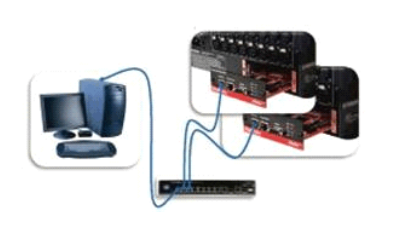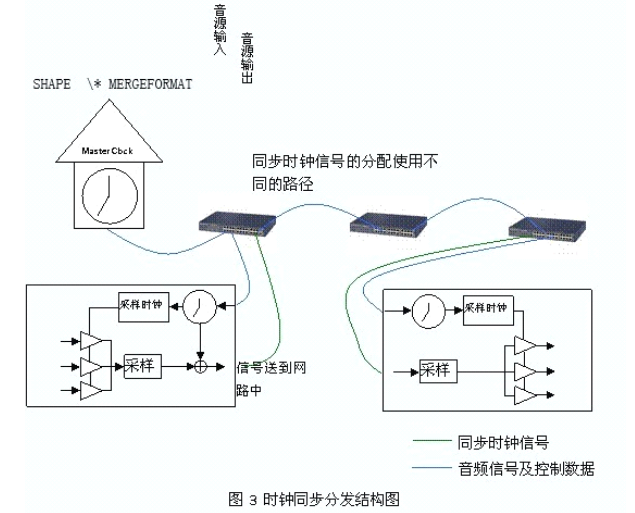On Dante digital audio transmission technology
On Dante digital audio transmission technology
1. Overview1. Overview
Dante digital audio transmission technology is a kind of IP network technology based on three layers, which provides a low delay, high precision and low cost solution for point-to-point audio connection. Dante technology can upload and send high-precision clock signal and professional audio signal in Ethernet (100m or 1000m) and carry out complex routing. Compared with the traditional audio transmission technology, it inherits all the advantages of CobraNet and ethersound, such as uncompressed digital audio signal, which ensures good sound quality; solves the complicated wiring problem in traditional audio transmission, reduces the cost; adapts to the existing network, without special configuration; audio signals in the network are labeled in the form of "label" And so on. At the same time, it has its own unique advantages:
1) Less latency. In 100m network bandwidth, when the total transmission audio channel is 3, the delay is only 34 μ s. Dante system can automatically adjust the available network bandwidth to minimize the delay time.
2) IEEE1588 precise clock protocol is used for clock synchronization.
3) Using the protocol of zeroconf (Zero Configuration Networking), using the automatic configuration server to check the interface device, identification label and distinguish IP address automatically, it does not need to start the high-level DNS or DHCP services, and saves the complex manual network configuration.
4) High compatibility of network. Dante technology allows audio signals, control data and other irrelevant data streams to be shared in the same network without interference. Users can use the existing network without establishing a special network for the audio system. For example, existing common TCP / IP devices (PC, etc.) can be added to Dante network, or some audio processing software, etc.
5) Self healing system. In order to avoid audio transmission interruption caused by accident, Dante system can set multiple self-healing mechanisms, such as clock loss, network failure, etc.
6) The transmission mode of audio channel can be unicast or multicast. Dante technology can be managed by IGMP (Internet group message protocol), which can filter or shield the broadcast audio channel according to the needs of the receiving point, which makes the multicast audio routing controllable.
These advantages will be the foundation stone of Dante technology in professional audio field and other engineering fields.
2. Dante audio transmission technology
At present, there are many network technologies available in IT industry, but Ethernet is still a stable, reliable and widely used protocol. So audinate running Dante on Ethernet has become a reasonable choice to cater to the market. Dante audio transmission technology allows audio signals to be transmitted arbitrarily in Ethernet using TCP / IP mode, and maintains the accurate restoration of signals in this process.
3. Basic principle, delay and synchronization
3.1 basic principles
Adopt dante-my16-aud card newly introduced by audinate company, plug it into voice server host and connect it with switch, as shown in the figure below, digital audio transmission based on Dante technology can be realized. It really realizes the "plug and play" function of audio network, which is convenient for those who do not know any network technology.

Dante technology uses Ethernet, which is considered as the fourth layer (transport layer) technology. It uses UDP for audio transmission and IP for audio routing over Ethernet, which is generally called UDP / IP protocol over Ethernet. The network connection diagram is as follows:

The audio signal is converted into UDP / IP network signal through voice server and transmitted to the network. The audio signal is routed to any other language server in the form of data packet on the network, and converted into analog signal to be provided to speakers or recording devices. For some processing devices, such as digital processors and digital mixers, it does not need digital / analog conversion, but directly processes packets in the network environment, and returns the same UDP / IP packets to the network for use by other devices. In this process, each device does not need to care about where its signals are to be routed or where they are from, which greatly reduces the configuration complexity of breakpoint devices. All routes can be completed by a special software, using one-to-one corresponding channel name.
3.2 network delay
Dante's transmission ability mainly depends on the network bandwidth, the number and location of sending and receiving points, single point or multi-point transmission and other factors. With Dante's network aided diagnosis function, IGMP management traffic and IP filter can be calculated quickly under the given unicast / multicast mode, and then help users determine whether such system connection meets the requirements. The bandwidth consumption of audio channel depends on the sampling frequency and resolution of audio signal.
In the network, the network delay is inversely proportional to the network bandwidth. In the case of unicast, the delay of an audio channel with the minimum sampling frequency is the shortest. It can be seen that with the increase of the number of audio channels or high sampling rate / resolution, the network delay will gradually increase. Dante system can automatically adjust the available network bandwidth and use as much spare bandwidth as possible under the premise of network transmission security to reduce transmission delay. The tradeoff automatic matching ability greatly improves the available freedom of the network, so that users no longer need to worry about the impact of traffic on signal transmission, as well as the resource load bearing capacity of the existing network.
Dante allows users to make a trade-off between network bandwidth and delay, that is, users can choose between the delay performance of the transmission signal and the bandwidth economy.
3.3 clock synchronization
Dante system uses IEEE1588 precise clock protocol for clock synchronization. The reference clock of IEEE1588 protocol adopts an election method to determine which device becomes the master clock and the standby clock generator. Each audio device in the network closely tracks the reference clock, which is identified by absolute time. The following figure shows the structure of clock synchronization distribution.

The transmission of digital audio signal can only be transmitted by superposing a sampling clock signal. The sampling signal is from its own clock oscillator, but the oscillator must be synchronized with the master clock at any time. If there is a deviation, Dante will automatically adjust the increase or decrease of the local clock to keep the synchronization with the network reference master clock. Because the IEEE1588 precise clock protocol used by Dante can achieve a very low jitter sampling rate (for example, 256 times supersampling), so it can really achieve high audio quality and low delay.
4. Dante transmission technology summary
Dante digital audio transmission technology is widely used in professional audio industry, broadcast system, teleconference system, building intelligent audio system, large-scale games and other industries with its strong advantages. Audio transmission is developing towards digitalization and networking. Dante network audio technology represents the future development direction of audio transmission technology.





